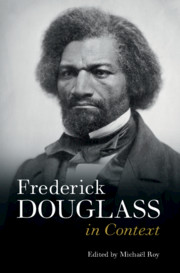Book contents
- Frederick Douglass in Context
- Frederick Douglass in Context
- Copyright page
- Contents
- Illustrations
- Contributors
- Chronology
- Abbreviations
- Introduction
- Part I Places
- Part II Genres
- Part III Activism
- Chapter 12 Abolition
- Chapter 13 Temperance
- Chapter 14 Women’s Rights
- Chapter 15 The Civil War
- Chapter 16 Reconstruction and Civil Rights
- Part IV Philosophy
- Part V Networks
- Part VI Afterlives
- Further Reading
- Index
Chapter 16 - Reconstruction and Civil Rights
from Part III - Activism
Published online by Cambridge University Press: 16 June 2021
- Frederick Douglass in Context
- Frederick Douglass in Context
- Copyright page
- Contents
- Illustrations
- Contributors
- Chronology
- Abbreviations
- Introduction
- Part I Places
- Part II Genres
- Part III Activism
- Chapter 12 Abolition
- Chapter 13 Temperance
- Chapter 14 Women’s Rights
- Chapter 15 The Civil War
- Chapter 16 Reconstruction and Civil Rights
- Part IV Philosophy
- Part V Networks
- Part VI Afterlives
- Further Reading
- Index
Summary
Most histories of Reconstruction begin their narrative in December 1863 when President Abraham Lincoln announced his Ten Percent Plan, reserving most of the authority to restore the collapsing Confederacy in the executive branch. Frederick Douglass also thought that Reconstruction began in 1863, but in January rather than in December. That month, after the final Emancipation Proclamation was issued, the War Department at long last permitted states to recruit black soldiers, which Douglass believed was the first step toward black citizenship and voting rights. Although Republicans envisioned Reconstruction as a policy only for the Confederacy, Douglass understood that the entire nation required political reclamation. If William Lloyd Garrison and a good number of white abolitionists assumed their struggle concluded with the ratification of the Thirteenth Amendment in December 1865, Douglass understood that the fight had just begun. He knew that the antithesis of slavery was not freedom, but equality.
Keywords
- Type
- Chapter
- Information
- Frederick Douglass in Context , pp. 194 - 206Publisher: Cambridge University PressPrint publication year: 2021



